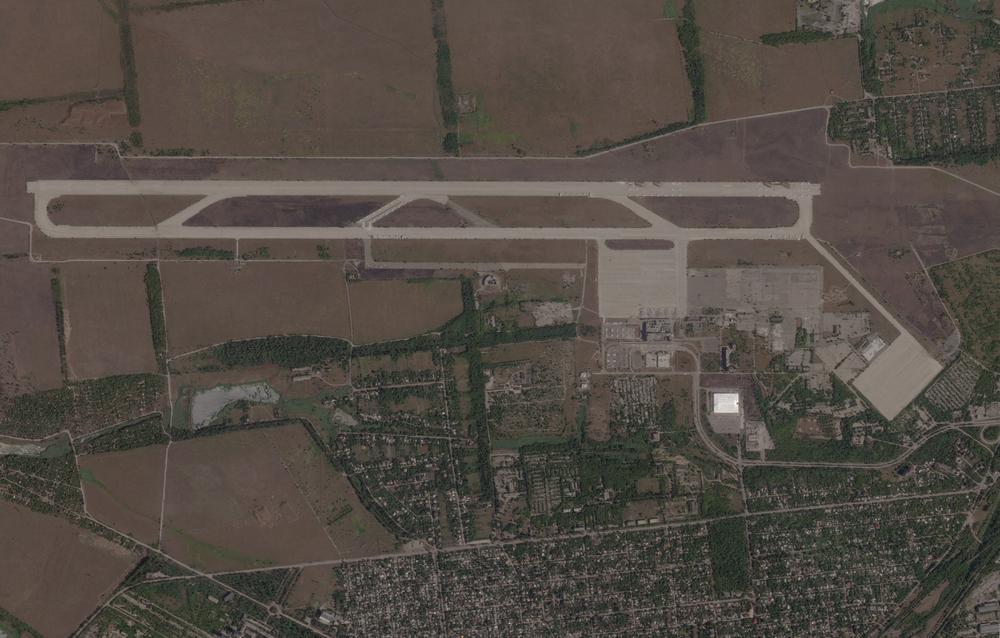Russia is turning the parts of Ukraine it occupies into a giant military base — and a potential launch pad for future aggression.
Moscow's forces in the occupied territories, particularly in the eastern Donetsk and Luhansk oblasts, are converting civilian infrastructure into bases to house its soldiers, transport ammunition, and launch its drones from closer than ever to Ukrainian-held territory.
Among the clearest examples is the Donetsk International Airport. Recent satellite images that Planet Labs provided to the Kyiv Independent show a sudden build-up on the foundations of the old airport, which had sat derelict for over a decade.
Ukraine had rebuilt the airport into one of the most modern in the country for the 2012 UEFA European Football Championship. Over a million passengers would pass through the renovated terminal annually, until war came to the area in 2014.
The airport was one of the last holdouts for Ukrainian soldiers in Donetsk until Russian-backed partisans overtook it at the end of 2014, blasting the new terminal down to its foundations. For almost eleven years, scars from artillery and explosions lay untouched on the runway.
Imagery from April of this year shows the airport looking exactly as desolate as it had since it was captured. But as of the end of July, Russian forces have repaved the landing strip. Little white shelters now fill the runway, and a fresh white hangar has cropped up on the bones of the old terminal.
The new airport structures, says Vadym Hlushko, founder of Ukrainian OSINT project Kiberboroshno, are all a launchpad for the ever-expanding flocks of Russia’s long-range drones.
"This is the so-called ramshackle infrastructure — garages for storing and launching kamikaze drones of the 'Shahed' type. In addition to the main launch installations, they also set up so-called 'decoys' — fake launch positions and false locations," Hlushko told the Kyiv Independent.
Hlushko warns that launches from Donetsk Airport may even allow Shaheds to fly armed with artillery shells that they can drop along the way to their final kamikaze attack.
It’s no secret that Russia is repurposing captured Ukrainian infrastructure for military use.
But as U.S. President Donald Trump floats "territorial swaps" as part of a peace deal between Ukraine and Russia that would include giving up all of Donetsk and Luhansk oblasts, which Russia does not fully control, Ukrainians fear the occupied territories have already become staging grounds for Russia’s next invasion.
The Institute for the Study of War has also warned that the threat of Russia’s forward bases extends to NATO member states.
"They are militarizing everything they can get their hands on," a woman from Donetsk who is an activist with the Zla Mavka partisan group and spoke on condition of anonymity, told the Kyiv Independent.
"The military occupies empty workshops, sets up barracks, and guards don't let anyone near. We don't even know what's inside, but everyone sees convoys driving in and out at night."
Much of Donbas "is already a Russian military base today," laments Petro Andriushenko, a native of Mariupol and a wartime advisor to the city’s mayor. Andriushenko started his new “Center for the Study of Occupation” at the start of this year.
What we see of Russia’s new military installations is, Andriushenko says, "probably less than 1% of what’s actually there. In almost every population center, there’s some kind of premises for Russian soldiers."
Recent videos posted by Russian soldiers on social media show, for instance, a factory that once produced tow trucks and tractors in Berdiansk, southwest of Mariupol, converted into a base after being captured in 2022.
A milk-producing plant in rural Dovzhansk, formerly called Sverdlovsk, is now a Russian vehicle repair base in the east of Luhansk Oblast. In Oleksandrivka, Donetsk Oblast, Russian forces recently turned a school into a tank shelter.
In Crimea and along the Azov Sea, Russian occupying soldiers have converted an endless string of former resorts into barracks. The Arabat Spit, for example, was a popular vacation spot before the full-scale invasion.
"Most of the Arabat Spit is empty now," said Serhii Danylov, a deputy head of the Association of Middle East Studies who also focuses on Kherson Oblast.
"It's no secret, if you look around Skladovsky and Zaliznyi Port, then every second children's camp or recreation base there is occupied by either Rosgvardia or Russian military personnel," said Hlushko, referring to two Black Sea ports in occupied Kherson Oblast.
A representative of the Crimean Combat Seagulls, a Ukrainian resistance movement active on the peninsula, who spoke on condition of anonymity, told the Kyiv Independent that Russian militarization of the territory has only accelerated since the start of the full-scale invasion.
"Crimea currently serves two functions: as a springboard for potential offensive operations and as a base for supplying Russian forces in southern Ukraine."
The representative noted the recent appearance of S-400 and Pantsir-S1 air defenses and Bal and Bastion anti-ship missiles. While the Crimean Combat Seagulls did not know the total number of Russian forces in Crimea, "there are dozens of garrisons and facilities of various levels, including airfields, naval bases, and missile complexes, ensuring the peninsula's full combat readiness."
Since 2014, Ukraine has also fortified many key towns remaining in Donetsk and Luhansk oblasts. This is how much-battered cities like Pokrovsk, Kupiansk, Kostyantinivka, and Kramatorsk have managed to hold out in the face of continuous Russian attacks by land and by air.
Based on the presence of mountains and man-made terykony, or slag heaps characteristic of the Donbas region that comprises Donetsk and Luhansk oblasts, the area is far more defensible than, for example, Dnipropetrovsk Oblast, which borders it immediately to the west and is largely steppe.
Handing over those well-protected cities in Donetsk and Luhansk oblasts as part of any peace deal risks forfeiting Ukraine's best fortifications to Russia.
And for those who live in these territories, Russia's militarization of the area is a bitter affront amid a deepening humanitarian crisis.
"The worst thing is that these changes are happening at the same time as we are fighting for the basics — for water to wash our children's hands or cook food," said a Zla Mavka resistance movement activist from occupied Donetsk.

 Nichols Cars a Pebble Beach: ecco la N1A ICON 88, vero tributo alle corse
Nichols Cars a Pebble Beach: ecco la N1A ICON 88, vero tributo alle corse